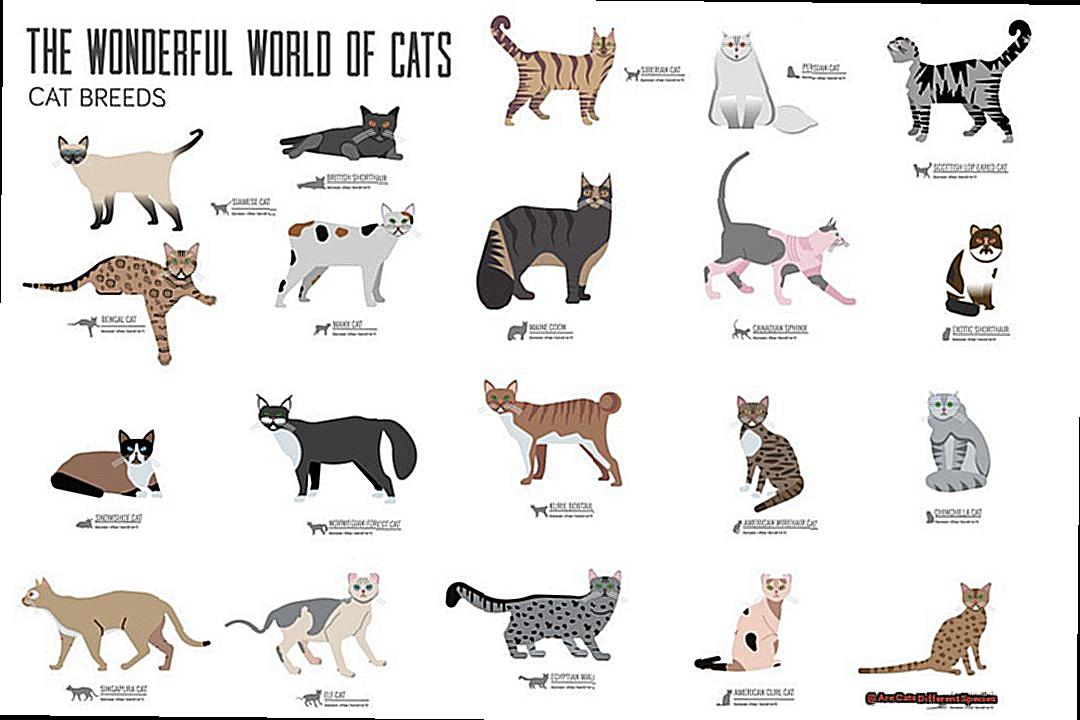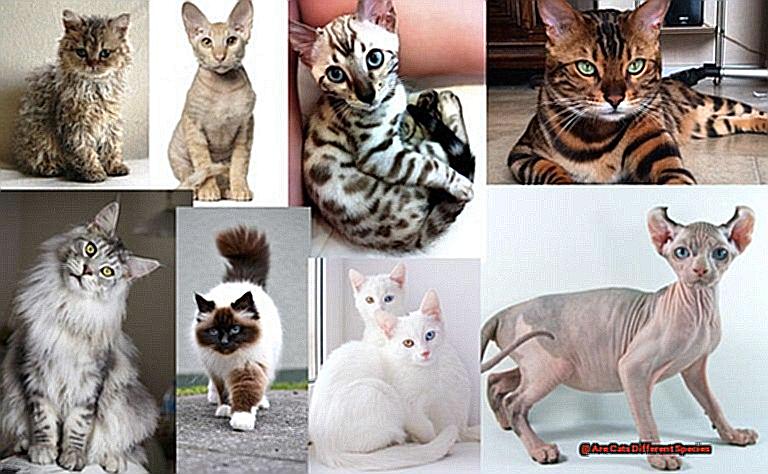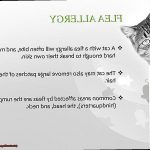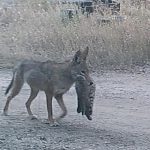Hey there, fellow cat lovers.
Contents
Are you ready to dive into the captivating world of our feline friends? Cats have been stealing our hearts since ancient times with their graceful movements and mysterious personalities.
But have you ever wondered if all cats are the same species? In this post, we’ll take a closer look at these fascinating creatures and uncover what sets them apart from other animals.
So sit tight, relax, and let’s embark on a journey to unravel the secrets of our favorite four-legged friends.
Are Cats Different Species?

When we think of cats, we often picture our beloved domestic companions, lounging in the sun or playing with a ball of yarn. But did you know that there are actually many different species of cats? That’s right, those cute and cuddly felines come in a variety of shapes, sizes, and behaviors. Let’s explore the fascinating world of feline diversity and debunk the common misconception that all cats belong to the same species.
The most well-known and widely kept species of cat is the domestic cat, or Felis catus. But there are also other species such as the African wildcat (Felis lybica), the Asian leopard cat (Prionailurus bengalensis), and the Pallas’s cat (Otocolobus manul). These different species have distinct physical characteristics, behavior patterns, and habitats.
One noticeable difference between cat species is their size. While domestic cats can weigh anywhere from 5 to 20 pounds, other species like the African lion can weigh up to a whopping 500 pounds. Talk about a size difference.
Another distinguishing factor is their coat patterns and colors. Domestic cats can have a variety of coat colors and patterns, while some wild cat species have more uniform coats for camouflage. For example, the African serval has bold spots on its coat to blend in with its surroundings.
But it’s not just appearance that sets these cats apart. Their hunting techniques also differ. Domestic cats are primarily solitary hunters, while big cats like lions and tigers hunt in groups. This is due to their different habitats and prey preferences.
Mating behaviors also vary among cat species. Domestic cats may mate with multiple partners throughout their life, while other species may form monogamous pairs or only mate during certain seasons. This diversity in mating habits helps ensure the survival of each species in their unique environments.
While these differences may seem vast, all cat species share common traits such as retractable claws, excellent eyesight and hearing, and a carnivorous diet. These are essential for their survival in the wild, regardless of their size or habitat.
Genetic Differences Between Domestic and Wild Cats
While they may share some common traits and behaviors, domestic cats (Felis catus) and wild cats (Felis silvestris) are actually considered different species. So what exactly sets them apart? Let’s dive into the fascinating world of cat genetics to find out.
The first thing to understand is that domestic and wild cats do have a common ancestor. The domestic cat’s ancestor is believed to be the African wildcat (Felis lybica), while the wild cat’s ancestor is the European wildcat (Felis silvestris). Over time, these two species diverged due to selective breeding and adaptation to different environments.
Chromosome Numbers
One of the most noticeable differences between domestic and wild cats is their chromosome numbers. Domestic cats have 38 chromosomes, while wild cats have 36 chromosomes. This difference is believed to be a result of domestication and selective breeding.
Digestion Differences
Another major genetic difference between domestic and wild cats is their ability to digest carbohydrates. Wild cats have a limited ability to digest carbohydrates, while domestic cats have evolved enzymes that allow them to digest carbohydrates more efficiently. This is because their diet has shifted from hunting prey to eating commercially produced food.
Genes for Traits and Behaviors
Domestic and wild cats also differ genetically in terms of certain genes related to behavior and physical traits. For example, domestic cats have a gene for tameness, while wild cats lack this gene. This explains why domestic cats tend to be more docile and social towards humans compared to their wild counterparts.
Coat Colors and Patterns
Aesthetically, domestic cats also possess a higher diversity of coat colors and patterns compared to wild cats. This is a result of selective breeding for desired physical traits, rather than natural selection for survival in the wild.
Reproductive Differences
In terms of reproductive behavior, domestic and wild cats also differ genetically. Domestic cats have a shorter gestation period and can breed throughout the year, while wild cats have a longer gestation period and breed seasonally.
Impact on Health
The genetic differences between domestic and wild cats also have an impact on their health. Domestic cats have been found to be more susceptible to certain diseases compared to their wild counterparts. This is due to their selective breeding history, which has focused more on physical appearance rather than overall health.
Interbreeding Between Domestic and Wild Cats
While domestic cats and wild cats belong to the same species, there are significant differences between them that make successful interbreeding a rare occurrence. In this blog post, we will explore these differences and the potential consequences of interbreeding between domestic and wild cats.
Domestic cats have been selectively bred for thousands of years, resulting in a diverse range of appearances, sizes, and temperaments. On the other hand, wild cats have evolved in their natural environments and have not been artificially selected by humans. This selective breeding has made domestic cats smaller in size compared to their wild counterparts, as they do not need the same strength and agility for survival. Additionally, domestic cats have evolved to be more social animals, forming bonds with both humans and other animals.
Due to this selective breeding, interbreeding between domestic and wild cats can lead to genetic issues. Wild cats have different genetic makeup due to natural selection, whereas domestic cats have been artificially selected by humans. This can result in health problems or traits that may not be suitable for either domestic or wild environments.
While there have been rare instances of interbreeding between domestic and wild cats, such as the Bengal cat breed which is a cross between a domestic cat and an Asian leopard cat, these crosses are carefully monitored and controlled to avoid potential health problems. In nature, interbreeding between domestic and wild cats is not commonly observed due to their distinct genetic makeup and differing behaviors.
The Debate Over Classification: Are Cats a Separate Species?
When it comes to classifying animals, scientists use a system called taxonomy to categorize them based on their physical characteristics and genetic makeup. This system helps us understand the relationships between different species and how they evolved over time.
Cats, being a part of the Felidae family, are no exception to this classification system. However, the ongoing debate among scientists is whether domestic cats should be classified as a separate species or a subspecies of the wildcat (Felis silvestris).
On one side of the argument, researchers point to genetic studies that show distinct differences between domestic cats and their wild counterparts. For example, a study led by Carlos Driscoll found that domestic cats have genetic markers that are not present in wildcats, suggesting that they have diverged from their wild ancestors.
This idea of genetic divergence is a key factor in determining species classification. With domestic cats being genetically distinct from wildcats, some argue that they should be classified as a separate species altogether.
On the other hand, there are researchers who believe that domestic cats should be considered a subspecies of the wildcat. They argue that while there may be some genetic differences, domestic cats are still able to interbreed with wildcats and produce viable offspring.
Additionally, some researchers point to the role of domestication in the evolution of cats. As humans began to domesticate cats thousands of years ago, they may have unintentionally influenced their genetic makeup through selective breeding. This could explain some of the genetic differences seen between domestic and wild cats.
Notable researchers who support the idea of domestic cats as a separate species include Carlos Driscoll and Stephen O’Brien. On the other hand, Mel Sunquist and Fiona Marshall argue for domestic cats as a subspecies.
Geographical location and cultural perceptions also play a role in this debate. In some parts of the world, such as Europe, domestic cats have been present for centuries and are seen as a separate species. However, in other regions, such as Africa, wildcats and domestic cats are still considered the same species.
Evidence for Classifying Domestic Cats as a Distinct Species
Many of us have a furry feline friend at home, but have you ever stopped to think about the unique characteristics that set domestic cats apart from their wild counterparts? In this section, we will delve into the evidence for classifying domestic cats as a distinct species and explore what makes them so special.
Evolutionary History:
Domestic cats have a long and complex history with humans, dating back to ancient civilizations such as Egypt. Over time, they have evolved and adapted to become the beloved pets we know today. This evolution has resulted in distinct physical and behavioral traits that set them apart from their wild ancestors.
Genetic Makeup:
Studies have shown that domestic cats have a unique genetic signature that differs from other felids, such as lions and tigers. This genetic divergence is believed to be a result of selective breeding and domestication by humans. This means that our house cats are not just miniature versions of their wild cousins, but rather a genetically distinct species.
Dietary Needs:
Unlike their wild counterparts who primarily hunt for food, domestic cats rely on humans for their nutrition. This has led to changes in their digestive systems and nutrient requirements, further supporting the argument for their classification as a distinct species. As responsible pet owners, it is important to ensure that we provide our cats with a balanced and appropriate diet to meet their specific needs.
Behaviors:
If you’ve ever seen your cat kneading on a soft surface or heard them meowing for attention, then you’ve witnessed some of the unique behaviors of domestic cats. These behaviors are not observed in wild cats and are thought to be a result of domestication. For example, kneading is believed to be a remnant of kittenhood when cats would knead their mother’s belly to stimulate milk production.
Social Interactions:
While wild cats are typically solitary animals, domestic cats have been observed forming social bonds with humans and other household pets. They also exhibit different communication methods, such as meowing and purring, which are not found in wild cats. This social behavior further supports the argument for classifying domestic cats as a distinct species.
The Role of Selective Breeding in Creating Genetic Variations Among Domestic Cats
From the sassy Siamese to the regal Persian, each breed of domestic cat has its own unique set of physical and behavioral traits. But have you ever wondered how these variations came to be? The answer lies in the process of selective breeding.
Selective breeding is the intentional breeding of animals with desirable traits to produce offspring with those same traits. This practice has been used for centuries, resulting in over 70 distinct breeds of domestic cats that we know and love today.
So, what exactly does selective breeding involve? It starts with choosing cats with desired traits and breeding them together. This can include physical characteristics such as coat color, pattern, and length, as well as behavioral traits like temperament and activity levels.
Over time, this process has created a wide range of genetic variations among domestic cats. Take the Siamese breed, for example. Their distinctive pointed coat and blue eyes are a result of selective breeding. Similarly, Persians have been bred for their long, luxurious coats and flat faces.
But why is this genetic diversity important? For one, it allows for the survival and adaptability of domestic cats in different environments. A Maine Coon’s thick, water-resistant coat is perfect for colder climates, while a Sphynx’s hairless body makes it better suited for warmer ones.
Moreover, selective breeding has not only created physical variations but also behavioral ones. Some breeds are known for being more affectionate and sociable, while others are more independent and aloof. This variety allows cat owners to choose a breed that best fits their lifestyle and preferences.
Recognized Breeds of Cats: Further Blurring the Lines Between Subspecies and Species
Cats have been domesticated for thousands of years, and with that domestication came the creation of different breeds. But have you ever wondered if your Siamese and your neighbor’s Maine Coon are actually different species? The truth is, they’re not. In fact, they’re all just variations within the same species – Felis catus.
The Cat Fanciers’ Association recognizes over 40 different breeds of domestic cats, each with their own distinct physical characteristics and personalities. From the sleek and slender Siamese to the fluffy and affectionate Persian, there is a breed for every cat lover out there. But how did these breeds come to be?
Through selective breeding. This process involves intentionally breeding cats with specific traits to create a desired look or personality. For example, breeding two cats with long hair can result in a litter of fluffy kittens, which eventually led to the creation of breeds like the Himalayan and the Ragdoll.
But don’t let the term “breed” fool you – these cats are still all members of the same species. They may look and act differently, but they can all interbreed and produce fertile offspring. This further supports the idea that these breeds are just variations within a single species.
It’s also worth mentioning that many of these recognized breeds have wildcat ancestors, such as the African wildcat or European wildcat. This further emphasizes that these breeds are just domesticated versions of their wild counterparts.
So why do we have so many different breeds of cats? Well, just like with dogs, humans have always been fascinated with creating new and unique breeds through selective breeding. And with cats being one of the most popular pets in the world, it’s no surprise that there are so many different breeds to choose from.
Conclusion
In conclusion, cats have captured our hearts and imaginations for centuries with their grace and mystery. But as we delved deeper into the world of feline diversity, we discovered that our beloved domestic cats are not all cut from the same cloth. From the African wildcat to the Pallas’s cat, there are many distinct species of cats with unique physical characteristics, behaviors, and habitats.
But what sets domestic cats apart from their wild counterparts? Through genetic studies, we have uncovered that domestic cats possess specific genetic markers and traits that differentiate them as a separate species from wildcats. This is further supported by their dietary needs, behaviors, social interactions, and even health concerns.
However, this distinction between species and subspecies becomes blurred when it comes to recognized breeds of domestic cats. Through selective breeding, humans have created over 40 different breeds with their own physical attributes and personalities. Yet at the core of it all, they are still members of one incredible species – Felis catus.
So whether you have a sassy Siamese or a regal Persian as your furry companion, remember that each one may look and act differently but they all belong to the fascinating world of feline diversity.






